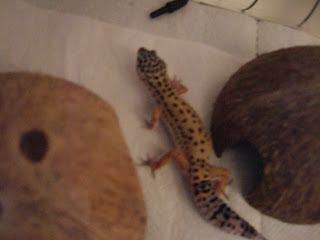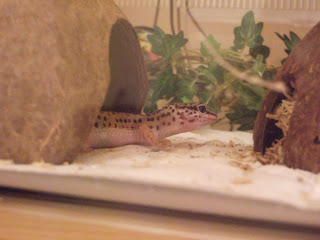While we were debating about getting the new viv, wifey had been looking up various threads in the Reptile Forums habitat forums . She came across a number of threads involving owners who built backgrounds into their vivs and how they managed it, some of the threads involved re-creating the pyramid from aliens vs predator aswell as other exotic looking backgrounds.
This is not the same sort of story, but let us begin our journey anyway. We decided to start off simple and went and bought some polystyrene, cement grout, silicone, coctail sticks, eco friendly clear varnish, stone texture spray paint aswell as some tester pots of paint. Firstly we measured the viv and decided to build a back ground that would cover the back and part of the sides (to provide more cover for our smudge).
Construction begins, we used the cocktail sticks to hold the structure together, before siliconing them.
Once we had the background sorted out we decided how many shelves we were going to have aswell as where we were going to place them, to get the edges wavy and to cut the polystyrene in general we used craft knives.
One shelf, Ha Ha Ha.
Two shelves, Ha Ha Ha
Close up of a shelf that has been sculptured using the craft knife.
Lots more shelves and on the right side of the picture a hide.
As you can see from the pictures above, I started attempting to sculpt the edges of the shelves to give them a much more realistic look.
Many more shelves plus steps!
Just a little readjustment.
And finished for the moment.
Once all the shelves were in place we then went about siliconing them down, this was quite tricky as we wanted to leave the cocktail sticks in place to provide extra support, we also realised at this point that the hide lid would have to come off and be attached later otherwise the insides of the hide wouldn't get properly covered in grout and varnish. Once the silicone was dry (this took a few days to let the fumes clear also) we went about grouting the back ground this didn't go to well to begin with as the grout wasnt sticking to the polystyrene, so what we did was found some old powder grout mixed it up and applied that first as it was more watery and easier to apply, then watered down our the cement grout slightly and applied it again.

After attempting to put the grout on without watering it down, didnt go too well which is why the back only got done.
After removing the hide lid, we were able to grout everywhere successfully.
Grouting in progress.
The contrast of colours of the different grouts used.

Finished with first layer of grout.
As you can see from the previous pictures the old powder grout was of a completely different colour but that was ok we knew we were going to cover it over with the cement grout which would be a better colour and texture. When watered down the cement grout was easily applied with brushes (we bought cheap ones which we wouldn't mind chucking away after wards).
And so the next layer of grouting begins.
A look at inside the hide.
More grouting.
Nearly done.
Voila! finished, the non grouted line you can see is where the hide lid would be placed.
Once finished grouting, we then attached the lid to the hide and added some more grout to cover the joins, we also sprayed some of the textured paint spray and added some extra colour to make it look more realistic. Once fully grouted we then applied about 3-4 coats of eco varnish; we purchased eco varnish mainly because we were concerned about the chemicals in varnish, online forums will usually recommend yacht varnish but we were unsure of where to purchase this and others did say as long as you gave the background time to air before putting it in your viv then alternative varnishes were ok, which is why we bought this eco friendly varnish we found in B & Q.
The finished product unfortunately we don't have any others of it with paint on etc.
This is not the end of our tale though, although we did measure it, when we tried to place it in the viv, wifey hadn't accounted for the front of the viv being that the doors start halfway up and unfortunately we couldn't squeeze it it through the top, so it had to literally have a third sliced off and be readjusted before it would fit! Unfortunately we don't have any pics of what it finally ended up looking like but I will hunt around and see if I can find it somewhere.


























